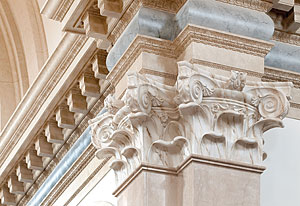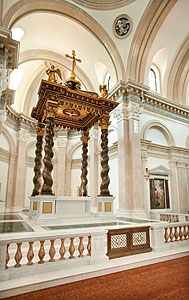Chapel Design Reflects College’s Mission
www.stonexp.com
2010-11-06 11:21:07
Popularity Index:0
Source:Internet
|
Meanwhile, Botticino Classico half columns articulate the Transept, and pairs of Rosso Levanto and Rosso Laguna half columns make up the four side shrines. In addition, an array of marble and other stone materials were selected for the chapel floor and other architectural details throughout the interior.
During material selection, construction of the chapel had already been underway, and Stroik explained that the columns were lifted by crane and dropped down over a steel column, like “threading a needle.” The use of steel columns to support the stone is an example of a departure from historic building methods, explained Elias Ghattas of Cleveland Marble in Orange, CA, which served as the stone installer for the project. “Centuries ago, stone columns were structural,” he said. “They were made of solid pieces and supported the structure. Today — and especially in California with its stringent seismic design requirements — solid natural stone cannot be used as structural support. The solid stone columns have to hide the 6-inch diameter structural steel columns. This meant that the columns would have to have a circular hole drilled through the entire shaft large enough to fit the structural steel columns, and they would have to be lifted approximately 50 to 60 feet high and inserted onto the structural steel columns. This has to occur immediately after the structural columns were in place, but prior to the completion of the structural steel of the project.”
Balancing the interior
Set in place before the marble flooring, the columns helped influence the floor patterns.
“We used the Botticino and Apuano as a tartan plaid and combined them with Emperador,” said Stroik. “One ancient solution which we employed was to have the column shafts as one marble with the bases another lighter color. The President really liked that because some of the tan veining in the white Apuano connected it to the Botticino Classico.”
With the column placement as the foundation of the grid, the interior floor pattern features marble throughout. Botticino Classico, Calacatta Apuano and Emperador Scuro can be found at the Nave and Transept, which also features a pattern of Rosso Asiago, Azul Macaubas, St. Daniel and Avorio Siena. The sanctuary floor is made of Verde Guatamela, Bardiglio Imperiale and Rosso Francia. |





